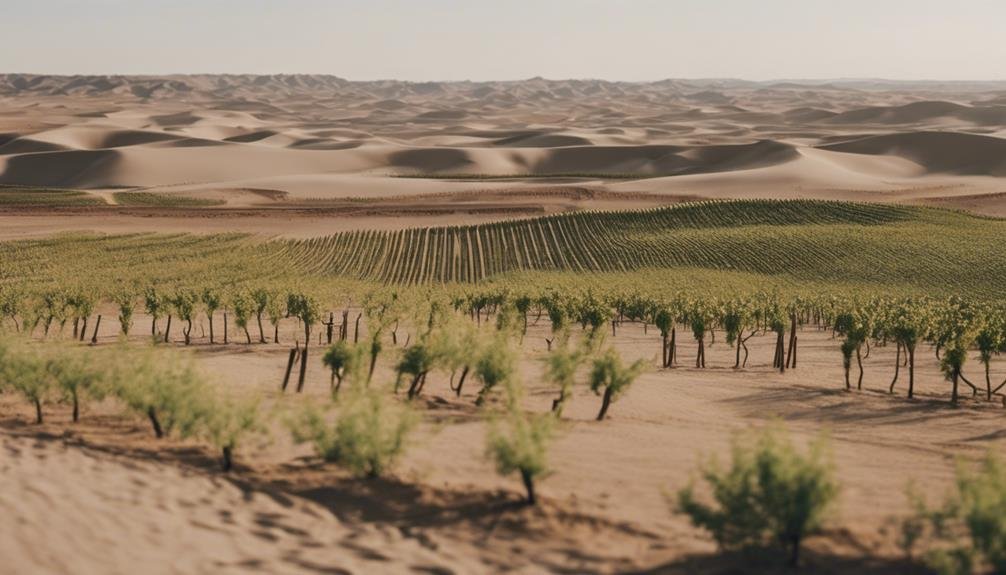Explore unique wine regions globally, like England with its Roman-era vineyards. Pico Islands in Portugal, a UNESCO site with vines thriving on basalt soil. Remarkable is the Gobi Desert, where Yellow River irrigation sustains subterranean vineyards battling extreme winters. Traditional winemaking methods here date back to ancient times, revealing the region's resilience. These diverse locations showcase nature's adaptability in producing exceptional wines.
Englands Wine Heritage
With a rich history dating back to the Roman Empire and further flourishing post the Norman Invasion, England's wine heritage is a tapestry woven with the threads of time, showcasing its evolution into a notable wine-producing region.
The Norman influence played a significant role in the proliferation of vineyards, with 139 active vineyards recorded in the early 1500s. King Henry VIII furthered this legacy, owning 11 vineyards himself. The remnants of this past can still be seen today, with echoes found in London's Vine Street.
These historical foundations laid the groundwork for England's growing reputation in the world of wine, setting the stage for the country to develop into a respected player in the global wine market.
Pico Islands Viniculture
Pico Island in the Azores, Portugal, boasts a unique and storied viniculture deeply intertwined with its UNESCO Historic Area status and the preservation of its precious Verdehlo vines.
The island's vineyards thrive in basalt terroir, with tiny plots of vines protected within man-made rock labyrinths dating back to the 1400s. Pico Verdehlo, highly treasured by European nobility, is a standout product of this region.
The soil composition of basalt rocks contributes to the distinct flavor profile of the wines produced on the island. Despite the challenges posed by the rugged terrain and harsh climate, Pico Island's winemakers have managed to create exceptional wines that reflect the unique terroir of this picturesque island.
Gobi Deserts Unique Vineyards

Gobi Desert in China presents a unique winemaking landscape characterized by vineyards that rely on the waters of the Yellow River for irrigation and innovative techniques such as burying vines underground to endure harsh winter conditions.
This underground winemaking method helps the vines survive the extreme cold of the desert winter. The Yellow River techniques are essential for these vineyards as the lack of water helps prevent diseases in the vines.
Notably, the oldest fermented beverage was discovered in the Yellow River basin, highlighting the historical significance of winemaking in this region. With 11 distinct wine regions in China, the Gobi Desert stands out for its adaptation to the challenging desert environment, showcasing the ingenuity and resilience of winemakers in this unique area.
Frequently Asked Questions
How Did Hindu Dietary Restrictions Influence Wine Production in Nashik, India?
Hindu dietary restrictions have greatly influenced wine production in Nashik, India. These influential practices have led to modern adaptations in cuisine pairing, emphasizing off-dry white wines. The region's climate, akin to California, Australia, and Spain, further enhances wine production.
What Makes Pico Verdehlo Treasured by European Nobles?
Pico Verdehlo is treasured by European nobles due to its unique Portuguese tradition and reputation as a European delicacy. The protected plots of Verdehlo vines on Pico Island, Azores, Portugal, produce exquisite wines highly esteemed by the elite.
Why Do Vineyards in the Gobi Desert Bury Their Vines Underground?
Vineyards in the Gobi Desert bury their vines underground to protect them from the extreme conditions, such as harsh winters and lack of water. This unique method helps vines survive and produce grapes in a challenging environment.
How Did Vineyards in England Evolve After the Norman Invasion?
After the Norman Invasion, English vineyards flourished under Norman influence, transforming into royal estates. The vineyards proliferated, with King Henry VIII owning 11 vineyards. A legacy of this era can still be seen in London's Vine Street, reflecting a rich viticultural history.
What Is the Significance of the Oldest Fermented Beverage Found in the Yellow River Basin?
The oldest fermented beverage found in the Yellow River basin holds immense significance due to its ancient techniques and cultural implications. It provides a window into the historical and cultural practices of early civilizations.
Conclusion
In exploring the diverse wine regions around the globe, it is evident that the world of viticulture is filled with unique stories and innovations.
One interesting statistic to note is that the global wine market is estimated to reach a value of $424.75 billion by 2027, showcasing the growing interest and demand for wines from all corners of the world.
As we continue to uncover new and unexpected wine regions, the future of wine production holds endless possibilities for discovery and enjoyment.